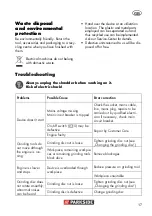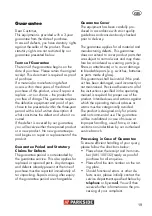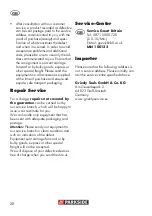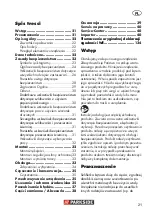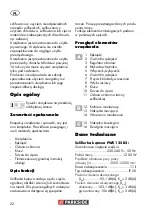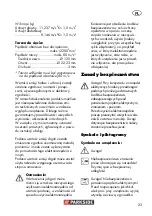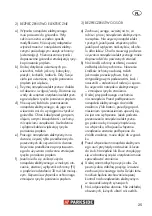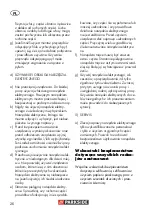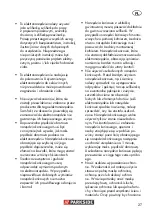
12
GB
Kickback
Kickback is the sudden reaction from a
chopping or blocked grinder attachment
such as a grinding disc, grinding plate,
wire brush etc. Chopping or blocking
leads to sudden stopping of the rotating
attachment. This causes an uncontrolled
electric tool to accelerate in a direction
counter to the rotational direction of the
attachment tool. If, for example, a grinding
disc cuts into the workpiece or blocks it,
the edge of the grinding disc that digs into
the workpiece can get caught and, through
that, break off the grinding disc or cause
a kickback. The grinding disc then moves
towards or away from the operator, depen-
ding on the direction of rotation of the disc
at the blocked spot. Here, the grinding
discs can also break. A kickback is caused
by wrongly or incorrectly operating the
electric tool. It can be avoided by suitable
cautionary measures, such as described
below.
a) Hold the electric tool very
firmly and bring your body and your
arm into a position in which you can
resist the kickback force. Always use
the supplemental handle if available to
give you the best control over kickback
force or reaction time during accele-
ration. The operator can master the
kickback and reaction force through
suitable precautions.
b) Never bring your hands near a rotating
attachment tool. The attachment tool
can run over your hand in the kickback.
c) Keep your body away from the area
in which the electric tool would move
during a kickback. The kickback drives
the electric tool in the counter-direction
to the rotation of the grinding disc at
the blocked spot.
d) Work particularly cautiously in corner
areas or where there are sharp cor-
ners etc. Prevent the attachment tools
from recoiling from the workpiece and
jamming. The rotating attachment tool
tends to jam when near corners, sharp
edges or when it recoils from such. This
causes a loss of control or kickback.
e) Do not use chain or toothed saw bla-
des. Such attachment tools frequently
cause a kickback or loss of control over
the electric tool.
Additional safety instructions
for sanding
Special safety instructions for
sanding:
•
Do not use overly large sand-
paper sheets; follow the
manufacturer‘s information for
sandpaper sizes.
Sandpaper sheets
which extend beyond the sanding plate
can cause injuries and can block, tear
the sandpaper, or cause kickback.
Additional safety instructions
for working with wire brushes
Special safety instructions for
working with wire brushes:
•
Be aware that the wire brushes
also lose wire pieces during typi-
cal use. Do not overload the wi-
res by pressing down too hard.
Flying wire pieces can very easily penet-
rate thin clothing and/or your skin.
•
If a protective hood is recom-
mended, do not allow the wire
brushes and the protective hood
to touch each other.
The diameter of
plate and cup brushes can enlarge if too
Summary of Contents for PWS 125 B2
Page 3: ...1 2 3 4 8 9 7 5 6 10 11 12 13 16 15 14 ...
Page 74: ...74 SI ...
Page 76: ...76 SI ...
Page 132: ...132 ...
Page 138: ...138 ...
Page 140: ...140 ...

















